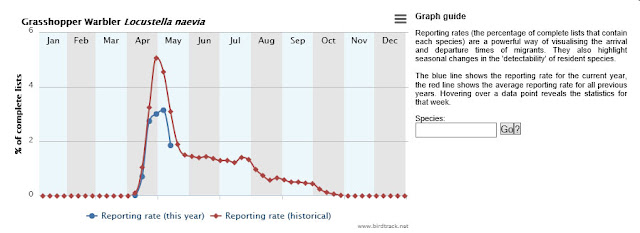Yesterday saw a good shake up in the weather, with a front arriving from the south overnight Tuesday/Wednesday producing strong winds and heavy rain. There was a bit too much rain on Wednesday morning for decent sea watching, but I gave it a go anyway! 07:40 - 08:40 from Spot On was wet and at times quiet, but another twenty minute watch from 09:45 with Phil showed a bit more was on the move once the worst weather had gone through. By mid morning the wind turned and began blowing from the north west which put a stop to any movement. My totals from both watches came to (flew west unless stated);
2 Great Northern Diver
1 Arctic Skua (dark-phased low west at 08:23)
41 Manx Shearwater
26 Kittiwake
20+ Sandwich Tern (6 west, 14+ fishing close in)
8 Common Tern (all looked like Commons to me anyway!)
12 Auk sp.
2 Ringed Plover (on the beach then flew west)
1 Dunlin (on the beach then flew west)
9 Sanderling (seven on the beach with the above two species, then all flew west joined by two more)
3 Whimbrel
A bit of rain and wind in early May always seems to drop Sanderling on Seaton Beach, my thanks to Phil for texting me about these. The seven settled birds ranged in plumage from full summer to just moulting out of winter wear...
 |
| Well concealed among the pebbles! |
 |
| Enjoying a well earned rest |
Wednesday wasn't a complete wash out though and the sun came out mid morning. A dog walk around the back lanes of Axmouth showed several singing male Common Whitethroat and a smart and fairly showy Lesser Whitethroat. I will keep an eye on it as it's a place I've never had one before. Lesser Whitethroats actually seem to be increasing in our bit of Devon over recent years, going against the grain of virtually every other migrant species!
Sadly I missed what was probably the best spring fall of long-distance migrants for several years on Sunday due to work, and it was only Kev who managed to get up to Beer Head and other sites around Beer. During the day he notched up six Redstarts, ten Whitethroats, four Spotted Flycatchers and a Garden Warbler, as well as excellent numbers of Willow Warblers constantly passing through. Who knows what else would have been discovered if more people were able to get out on the day, sadly Clive and Ian Mc were both away and Phil and I were working.
Although I missed all the passerines on Sunday, I was fortunate to luck in on a couple of Red Kites that flew low west over Seaton in the early evening, causing mayhem among the gulls. Tim White had seen them arrive from the east and I just happened to be driving through town when I noticed all the commotion. They really were low, not that you can tell that from my photos, but they did gain height again as the headed off west.
 |
| Amazingly my first Red Kite of the year! |
 |
| Red Kite with the light sadly behind it! |
Not got much else to tell really despite this being my first blog post for a week. There are more Reed and Sedge Warblers in now, and Friday 27th saw a truly impressive arrival of Swallows with flock after flock arriving low over the beach. Always so thrilling to see active migration like this. That evening Phil saw an Osprey, or maybe two, fishing on the Estuary - like so many species it's been a poor spring for them.















